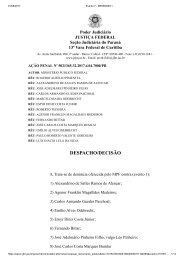Brasil só deve dominar Leitura em 260 anos, aponta estudo do Banco Mundial Relatorio Banco Mundial _Learning
Create successful ePaper yourself
Turn your PDF publications into a flip-book with our unique Google optimized e-Paper software.
student outcomes at the school level—make it hard to<br />
manage and monitor learning. These challenges may<br />
be exacerbated if private schools are a major player,<br />
because those schools typically operate outside the<br />
direct control of the public syst<strong>em</strong> (box 9.3).<br />
Some things are easier to monitor. 22 School building<br />
and cash transfer programs are highly visible and<br />
easily monitored investments aimed at expanding<br />
access. By contrast, investments to raise teacher competence<br />
or improve the curriculum are less visible, and<br />
monitoring their impact on student learning is more<br />
difficult. Such challenges can sometimes prompt education<br />
syst<strong>em</strong>s to <strong>em</strong>phasize improv<strong>em</strong>ents in access<br />
over improv<strong>em</strong>ents in quality. 23 Even when syst<strong>em</strong>s<br />
Box 9.3 Can private schooling be aligned to learning for all?<br />
Private schools play a major role in education, even for the<br />
poor. Globally, roughly one in eight primary school students<br />
attends a private school. At the secondary level, the number<br />
rises to one in four among middle-income countries<br />
(table B9.3.1). a The numbers are similar for low-income<br />
countries, where they may be underestimates if informal<br />
schools are undercounted. b In some places, the share of<br />
students attending private schools is much higher than<br />
these global figures. In one Nigerian state, 57 percent of<br />
all basic education learners attend private schools. c These<br />
enrollments are not limited to high-income households.<br />
In slum communities in Nairobi, Kenya, 43 percent of the<br />
poorest quintile of families send their children to private<br />
schools. This is higher than the proportion among the richest<br />
quintile of families in nonslum communities who send<br />
their children to private schools (35 percent). d In Jamaica,<br />
10 percent of learners from the poorest economic groups<br />
enroll in private schools. e<br />
Low-income households are willing to make this sacrifice<br />
because they perceive that private schools deliver<br />
better education at comparable cost. In many countries,<br />
parents say that teacher absenteeism is lower in private<br />
schools and that learning outcomes are better. f In Jamaica<br />
and South Africa, parents suggest that private schools are<br />
safer than public schools. g Furthermore, although public<br />
primary education is formally free in the vast majority of<br />
countries, many informal fees r<strong>em</strong>ain, reducing the cost<br />
difference between public and private schools.<br />
But there is no consistent evidence that private schools<br />
deliver better learning outcomes than public schools, or the<br />
opposite. In Colombia, India, and the United States, experimental<br />
evaluations of the consequences of enrolling in a<br />
private versus a public school show mixed results. h In some<br />
contexts, private schools may deliver comparable learning<br />
levels at lower cost than public syst<strong>em</strong>s, often by paying<br />
lower teacher salaries. i Even so, lower teacher salaries may<br />
reduce the supply of qualified teachers over time.<br />
Much of the evidence cited in this debate is nonexperimental,<br />
so it may conflate the effects of private schools<br />
th<strong>em</strong>selves with the effects of the type of students who<br />
enroll in private schools. Comparisons across 40 countries<br />
that seek to adjust for these differences in student characteristics<br />
find no private school advantage in the vast<br />
majority of countries. j Moreover, little rigorous research has<br />
assessed the effects of private schooling on students’ values<br />
or on the long-term health of the public school syst<strong>em</strong>.<br />
From a public policy perspective, how should governments<br />
view the growth in private schooling? Should<br />
Table B9.3.1 Private providers account for a significant share of school<br />
enrollment<br />
Percentage of learners enrolled in private education, by country income group (2014)<br />
Country income group Preprimary Primary Secondary<br />
Low-income 57 14 20<br />
Middle-income 42 13 25<br />
High-income 42 12 20<br />
Source: World Bank (2017a).<br />
(Box continues next page)<br />
176 | World Development Report 2018








